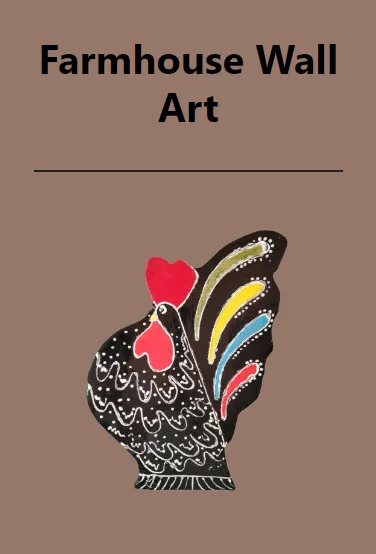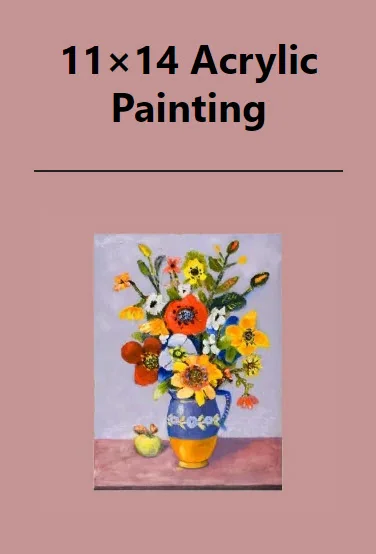Using The Raku Method
Raku firing is a low-temperature firing method. The pottery is removed from the kiln while the pots are hot and the glaze is still molten. Raku is typically made from stoneware clay. Raku firing is bisque fired at 900 °C or 1,650 °F. And glaze fired between 800 to 1,000 °C or 1,470 to 1,830 °F. Raku firing falls into the cone 06 firing temperature range. Raku firing is much quicker than normal firing.
During a Raku firing, volatile portions of compounds and molecules in the clay/glaze breaks free and the free oxygen attaches to the remaining material.
This forms what is called oxides. This process is called oxidation. The oxidation alters the color of the glaze and also changes the texture of your clay. The changes can sometimes be dramatic.
Sen no Riky, a Japanese tea master (Japanese ceramics), was engaged in the construction of the Jurakudai in the 16th century and had a tilemaker called Chjir create hand-moulded tea bowls (ceramic art) for use in Riky’s ideal wabi-styled tea ceremony.
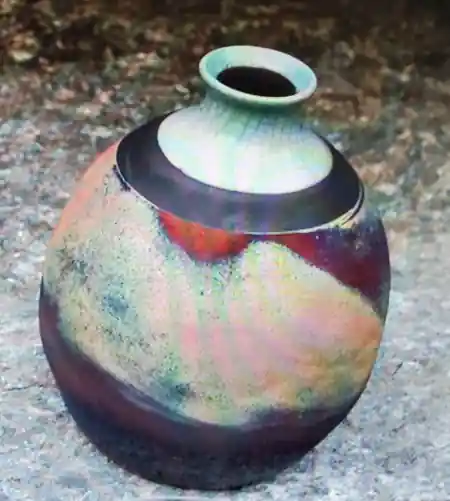
Chjir’s resultant tea bowls were first known to as “ima-yaki,” or “current pottery,” and were later dubbed Juraku-yaki, after the red clay or Juraku that they used.
Toyotomi Hideyoshi gave Jokei, Chjir’s son, a seal with the Chinese symbol raku, which means “enjoyment.” The name Raku was then given to the Raku family that made the items.
The name, as well as the pottery technique, has been passed down down the generations. The name and style of ceramics have become well-known in Japanese culture.
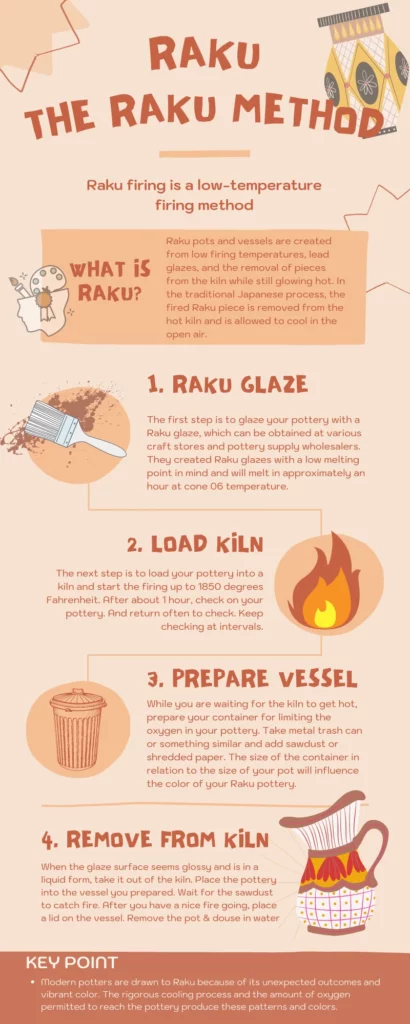
1. Raku Glaze
The first step is to glaze your pottery with a Raku glaze, which can be obtained at various craft stores and pottery supply wholesalers. They created Raku glazes with a low melting point in mind and will melt in approximately an hour at cone 06 temperature. Any glaze that’s formulated to fire at a low temperature or low-firing process can be used. For the Raku method to create an impact and a faster melting point, a thin coating of glaze is preferable. And for Raku experts, higher mid-range glazes can be used.
2. Load Kiln
The next step is to load your pottery into a kiln and start the firing up to 1850 degrees Fahrenheit. After about 1 hour, check on your pottery. And return often to check. Keep checking at intervals. When I have my kiln running I always like to stay nearby and check in often. I do not have a kiln that sends out a text message when done. When you see your glaze starting to bubble, you know things are going well. Continue to leave in the kiln for another 15 minutes after glaze bubbling. Then on to the next step.
3. Prepare Your Vessel
In the meantime, while you are waiting for the kiln to get hot, you can prepare your container or vessel for limiting the oxygen in your pottery. Take a metal trash can or something similar and add sawdust or shredded paper. The size of the container in relation to the size of your pot is important. This will influence the color of your Raku pottery. The container should be slightly larger than your pottery. The tighter the container around your pottery, the less oxygen, the richer the color.
You will also need to prepare a second vessel or container with water. Pour in enough water so your pot can the dunked.
4. Removing Raku From The Kiln
When your pottery is scorching red hot and the glaze surface seems glossy and is in a liquid form, you know it’s time to take it out of the kiln. Usually, more than one person is needed to facilitate moving the pottery from the kiln to the vessel. As always, the appropriate safety gear is needed. Adequate protection is needed as the pot will be very hot. Plus, there will be dangerous fumes, so protection is needed from the smoking pottery.
In the 1960s, American potter Paul Soldner proposed the use of a reduction chamber at the conclusion of the Raku firing to compensate for the difference in environment between wood-fired Japanese Raku kilns and gas-fired American Raku kilns.
Open the kiln and take out the pottery. Place the pottery as quickly as possible safely into the vessel you prepared earlier. Wait for the sawdust or newspaper to catch fire. After you have a nice fire going, place a lid on the vessel. This will retain heat in the container and smoke will start to bellow. Let the smoke take effect and then carefully remove the lid to the vessel. At this point, to cool the vessel, you can pour water and remove the pot and douse it into a bucket of water. Now you should be able to immediately see the beautiful effect of Raku firing.
Raku ware
Raku ware is a type of Japanese pottery traditionally used in Japanese tea ceremonies. It is traditionally characterized by being hand-shaped rather than thrown, pots and vessels (no pottery wheel used – hand building is used). These pots and vessels are created from low firing temperatures (results are fairly porous vessels), lead glazes, and the removal of pieces from the kiln while still glowing hot. In the traditional Japanese process, the fired Raku piece is removed from the hot kiln and is allowed to cool in the open air.
Studio potters created the Western variant of Raku in the twentieth century. Typically, wares are fired at a high temperature and then placed in an open-air container loaded with flammable material after being removed from the kiln, which is not a traditional Raku method in Japan. The Western method can produce a wide range of colors and surface effects, making it popular among studio and hobby potters.
Normally, temperature changes (or temperature variations) in the kiln are carefully monitored and occur gradually throughout ceramic firing. This is a method of safeguarding the pottery from temperature fluctuations.
Modern potters are drawn to Raku because of its unexpected outcomes and vibrant color. The rigorous cooling process and the amount of oxygen permitted to reach the pottery produce these patterns and colors.
The pottery is either immediately cooled in water, slowly chilled in the open air, or placed in a barrel filled with flammable material, such as newspaper, covered, and allowed to smoke, depending on the desired effect. Water cools the pottery quickly, halting the glaze’s chemical processes and allowing the colors to set.
Smoke is produced by the combustible material, which colors the unglazed sections of the pottery black. The quantity of oxygen permitted during the fire and cooling process has an impact on the color of the glaze as well as the degree of crackling.
Unlike traditional Japanese Raku, which consists mostly of handcrafted bowls with simple designs, Western Raku is brightly colored and comes in a variety of forms and sizes. Western Raku (Unlike traditional Japanese raku, which consists mostly of handcrafted bowls with simple designs, western raku is brightly colored and comes in a variety of forms and sizes) can range from a simple vase to a bizarre abstract sculpture. Most western potters utilize throwing wheels to create their Raku pieces, however, some do hand construct.
Horse hair Raku
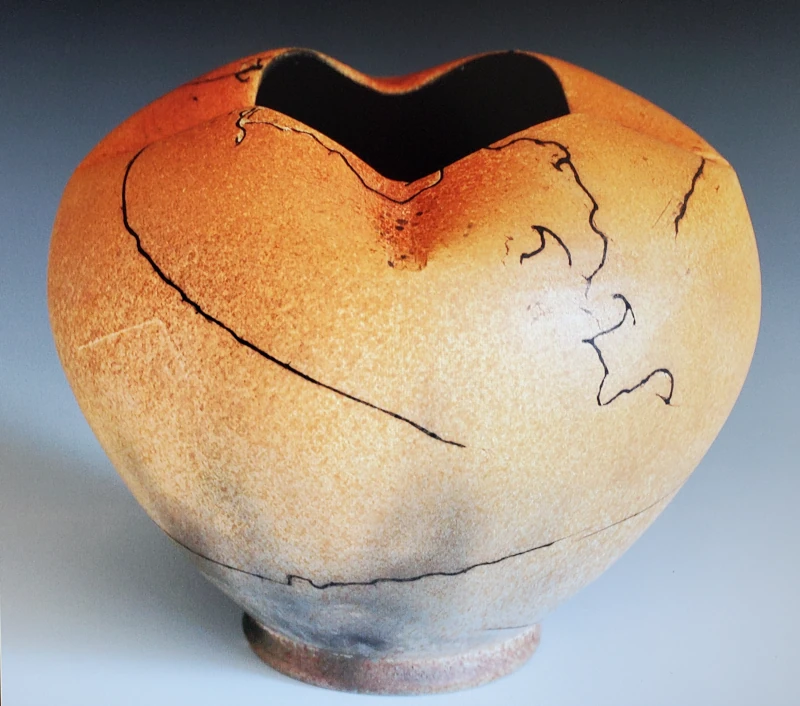
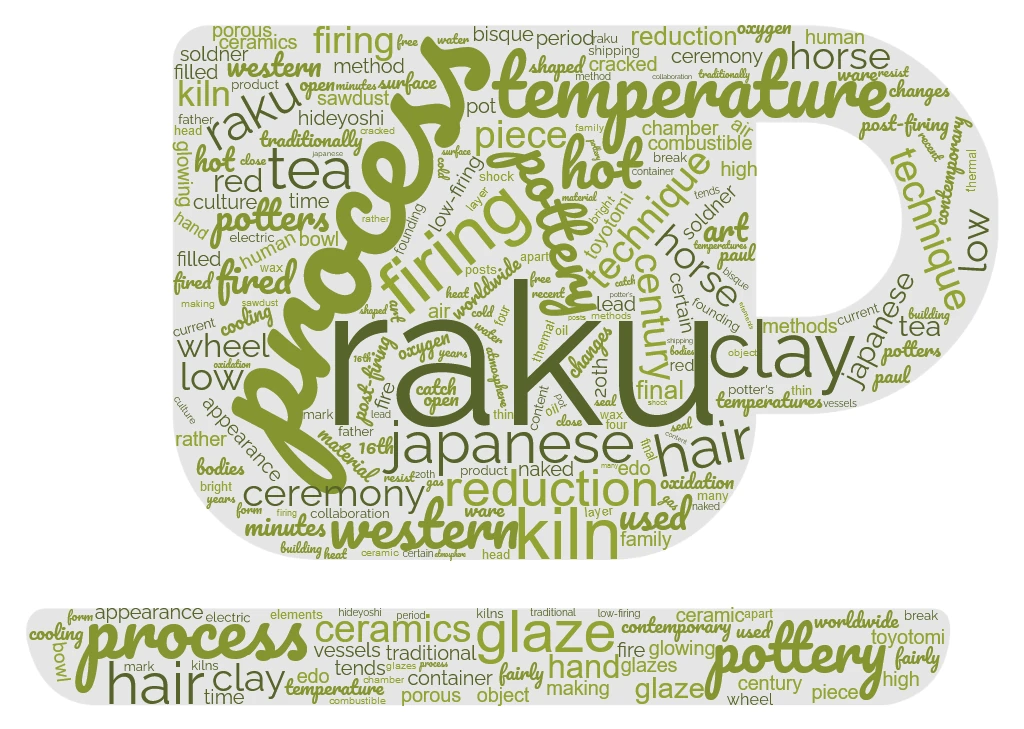
Horse hair Raku is a new sub-branch of Raku established by Western culture. White pieces with squiggly black lines and smoke-like smudges are common. These effects are achieved by applying horse hair, feathers, or even sugar to the pottery while it is still hot from the kiln. Folks have even used human hair to get a similar effect.
References
https://upload.wikimedia.org/wikipedia/commons/7/79/Western-raku-vase.jpg
https://en.wikipedia.org/wiki/Paul_Soldner
Ali, A., Jalil, A. R., Salleh, M. R., & Anwar, R. (2015). The exploration methods of consistent Raku firing glaze effect framework. In International Colloquium of Art and Design Education Research (i-CADER 2014) (pp. 153-159). Springer, Singapore. https://link.springer.com/chapter/10.1007/978-981-287-332-3_17
Branfman, S. (2009). Mastering Raku: Making ware, glazes, building kilns, firing. Sterling Publishing Company, Inc.. https://books.google.com/books?hl=en&lr=&id=lawxTE00QA4C&oi=fnd&pg=PA8&dq=Raku+Firing+pottery&ots=LUJ3cBu0RA&sig=QwNFa4NecB497vgoynsPYfH9M4A#v=onepage&q=Raku%20Firing%20pottery&f=false
Haley, Michael. “An exploration of the development and use of colored clay in Raku firing.” PhD diss., 1977.
Aris, K. N. M. (2013). The Influence and Remaining Japanese Cultural Elements in Raku Artworks of Contemporary Non Japanese Artists/Potters. The University of New South Wales, Australia. https://terebess.hu/gabor/Raku-Artworks.pdf

